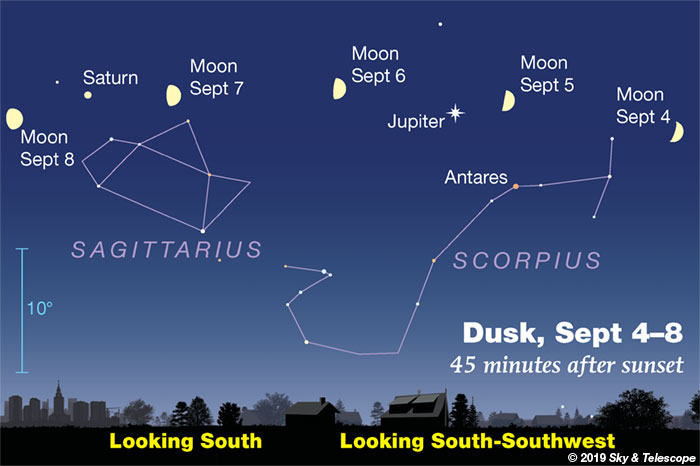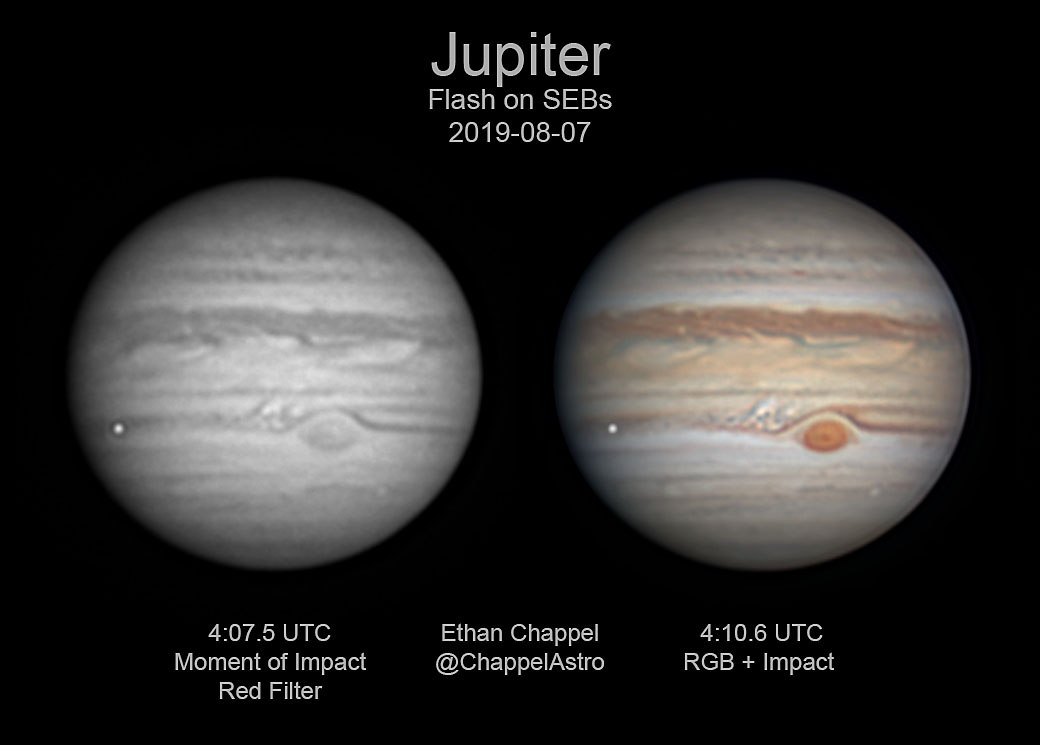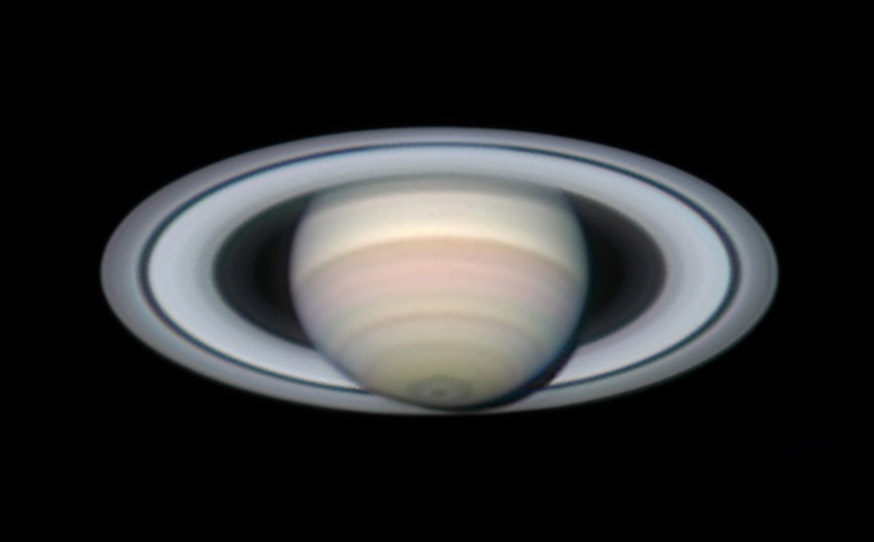
Friday, Aug. 30
• The Milky Way extends upward from the low south-southwest just after dark. Before the Moon becomes bright later this week, this is your last good chance this year to finally get straight which clumps are the Large Sagittarius Star Cloud (with M8 above it), the Small Sagittarius Star Cloud (a.k.a. M24), the lesser-known Gamma Scuti Star Cloud, and the Scutum Star Cloud on top. In a dark sky they stand out almost ladder-like. See the labeled photo with Fred Schaaf's "Musings on Eternity" in the September Sky & Telescope, page 45.
• New Moon (exact at 6:37 a.m. on this date EDT.)
Saturday, Aug. 31
• Altair is the brightest star on the southern side of the sky after dark. (We're not counting the planets Jupiter and Saturn, far to its lower right.) Spot Altair's little orange companion Tarazed to its upper right by just a finger width at arm's length.
Look to Altair's upper left, by a bit more than a fist, for little Delphinus, the Dolphin.
Closer above Altair is even smaller, fainter Sagitta, the Arrow.
Sunday, Sept. 1
• By 9 or 10 p.m. two of the most famous deep-sky objects, the Double Cluster in Perseus and the Great Andromeda Galaxy M31, are in high view in the east. Did you know they're only 22° apart? They're both cataloged as 4th magnitude but to the naked eye they look rather different, the more so the darker your sky. See for yourself; they're plotted on the all-sky constellation map in the center of the September Sky & Telescope, which should be all the map you need to identify their locations. Sky too bright? Use binoculars!
The two clusters of the Double Cluster (NGC 869 and NGC 884) are at very similar distances about 7,600 light-years away. M31, at 2.5 million light-years, is about 330 times farther out.
Monday, Sept. 2
• Whenever bright Vega crosses nearest your zenith, as it does at nightfall now, you know that the Sagittarius Teapot must be at its highest due south even if it's hidden by buildings or trees (or twilight). The Teapot is currently under Saturn.
Two hours later when Deneb crosses closest to the zenith, it's the turn of Delphinus and boat-shaped Capricornus down below to stand at their highest in the south.
Tuesday, Sept. 3
• Even with a modest telescope under a mediocre sky, did you know you can see the black-hole microquasar Cygnus X-1 — or rather the 9th-magnitude star feeding it? It's 0.4° east of 4th-magnitude Eta Cygni high overhead. For a finder chart, you can use the photo that leads Dave Tosteson's "Microquasars" in the September Sky & Telescope, page 57. Celestial north there is up and east is to the left.
Wednesday, Sept. 4
• The Moon at dusk hangs left of Jupiter, Antares, and the head of Scorpius, as shown at the top of this page.
• A winter preview: Step out before the first light of dawn this week, and the sky displays the starry panorama it will after dinnertime in late January and early February. Orion strides up in the southeast, with Aldebaran and then the Pleiades high above it. Sirius sparkles far below Orion. The Gemini twins are lying on their sides well up in the east.
Thursday, Sept. 5
• First-quarter Moon (exact at 11:10 p.m. EDT). It poses in an interesting setting. As the stars come out, you'll find Jupiter shining a few degrees to the Moon's left (for North America) and dimmer orange Antares twinkling farther below it. See the top of this page.
• Neptune, magnitude 7.8, tonight is a mere 3/4 arcminute or so east of Phi Aquarii, a 4th-magnitude orange star. You'll need a telescope. They're well up in the southeast by about 10 p.m. and highest in the south soon after midnight. They'll be 1 arcminute apart Friday evening, then they widen by about 2 arcminutes a day after that.
Friday, Sept. 6
• The two brightest stars (not planets) of September evenings are Vega high overhead and Arcturus in the west, both magnitude 0.
Draw a line from Vega down to Arcturus. A third of the way down you cross the dim Keystone of Hercules.
Two thirds of the way down you cross the dim semicircle of Corona Borealis with its one modestly bright star: Alphecca, the gem of the crown.
Well to the right of Arcturus, in the northwest, the Big Dipper is turning more and more level.
Saturday, Sept. 7
• Look left of the gibbous Moon at dusk for Saturn, as shown at the top of this page. Below the Moon, can you piece out the Sagittarius Teapot?
________________________
Want to become a better astronomer? Learn your way around the constellations. They're the key to locating everything fainter and deeper to hunt with binoculars or a telescope.
This is an outdoor nature hobby. For an easy-to-use constellation guide covering the whole evening sky, use the big monthly map in the center of each issue of Sky & Telescope, the essential guide to astronomy.

Once you get a telescope, to put it to good use you'll need a detailed, large-scale sky atlas (set of charts). The basic standard is the Pocket Sky Atlas (in either the original or Jumbo Edition), which shows stars to magnitude 7.6.
Next up is the larger and deeper Sky Atlas 2000.0, plotting stars to magnitude 8.5; nearly three times as many. The next up, once you know your way around, are the even larger Interstellarum atlas (stars to magnitude 9.5) and Uranometria 2000.0 (stars to magnitude 9.75). And read how to use sky charts with a telescope.
You'll also want a good deep-sky guidebook, such as Sue French's Deep-Sky Wonders collection (which includes its own charts), Sky Atlas 2000.0 Companion by Strong and Sinnott, or the bigger Night Sky Observer's Guide by Kepple and Sanner.
Can a computerized telescope replace charts? Not for beginners, I don't think, and not on mounts and tripods that are less than top-quality mechanically (meaning heavy and expensive). And as Terence Dickinson and Alan Dyer say in their Backyard Astronomer's Guide, "A full appreciation of the universe cannot come without developing the skills to find things in the sky and understanding how the sky works. This knowledge comes only by spending time under the stars with star maps in hand."
This Week's Planet Roundup

Mercury, Venus, and Mars are out of sight behind the glare of the Sun.
Jupiter (magnitude –2.2, between the feet of Ophiuchus) is the white dot hanging in the south-southwest as twilight fades away. Get your scope on it early before it sinks lower into poorer seeing. Orange Antares, much fainter at magnitude +1.0, twinkles 7° to Jupiter's lower right. In a telescope, Jupiter is only 39 arcseconds wide and shrinking.

Saturn on August 23rd, imaged by Damian Peach with the 1-meter Chilescope. South is up. "Poor to fair seeing allowed a reasonable result," he writes. That's being modest. With a scope that large at a latitude where Saturn is high overhead, the North Polar Hexagon and its central dark spot show here clear as day.
Saturn (magnitude +0.3, in Sagittarius) is the steady, pale yellowish "star" in the south-southeast during and after dusk, 30° left or upper left of Jupiter. Below Saturn is the handle of the Sagittarius Teapot.
Uranus (magnitude 5.7, in Aries) is well up in the east by midnight and highest in the south before the beginning of dawn.
Neptune (magnitude 7.8, very close of 4th-magnitude Phi Aquarii this week) is well up in the southeast by 10 or 11 p.m. and highest in the south by 1 or 2 a.m. Neptune is almost at opposition. Finder charts for Uranus and Neptune.
_________________
All descriptions that relate to your horizon — including the words up, down, right, and left — are written for the world's mid-northern latitudes. Descriptions that also depend on longitude (mainly Moon positions) are for North America.
Eastern Daylight Time (EDT) is Universal Time (UT, UTC, GMT, or Z time) minus 4 hours.
_________________
Audio sky tour. Out under the evening sky with your earbuds in place, listen to Kelly Beatty's monthly podcast tour of the heavens above. It's free.
_________________
"The dangers of not thinking clearly are much greater now than ever before. It's not that there's something new in our way of thinking, it's that credulous and confused thinking can be much more lethal in ways it was never before."
— Carl Sagan, 1996
 1
1








Comments
misha17
August 30, 2019 at 7:28 pm
The front 2 (western) stars of the Great Square of Pegasus "point" down to Fomalhaut, the brightest star in the constellation Pisces Austrinus. The back 2 (eastern) stars of the Great Square "point" down to the variable star Mira in the constellation Cetus. It's expected to reach maximum brightness in mid-late October, and is still early in its brightening cycle. I was awake around 1am this morning and went out to check them out; they were both low in the sky and there was a lot of haze (but no clouds). Under those conditions they appeared to be close to the same brightness.
You must be logged in to post a comment.
You must be logged in to post a comment.